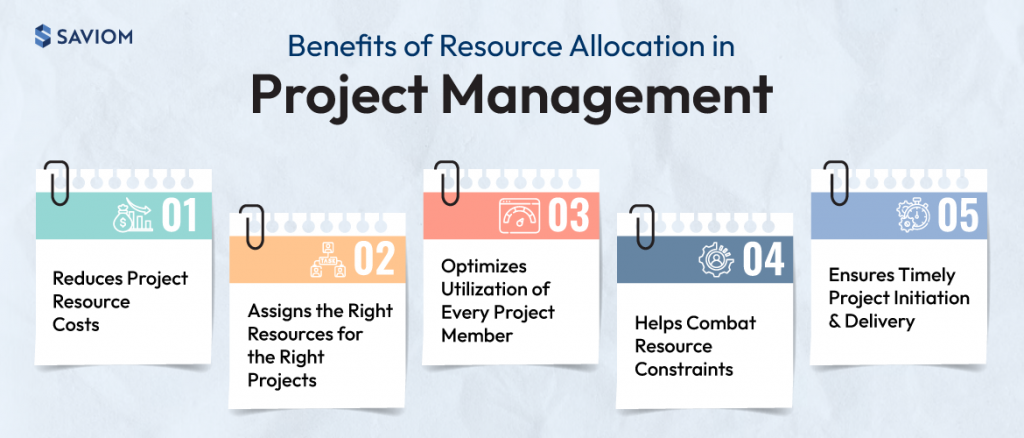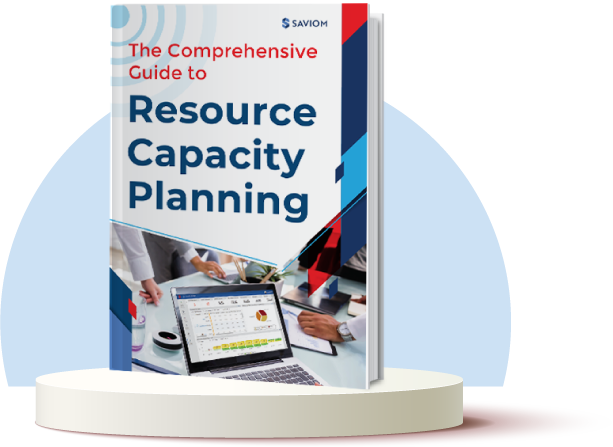According to a McKinsey survey, “83% of business leaders consider proper resource allocation as a critical management lever for growth.”
Resources, including human capital, financial assets, equipment, and others, are critical assets for any organization and their allocation can make or break a project’s success. As a result, it is important to carefully plan and distribute these resources across various project activities, ensuring that the right ones are assigned to the right tasks at the right time.
Effective resource allocation is also about striking the right balance between competing priorities, optimizing resource utilization, and continuously monitoring and adjusting allocations as the project progresses. It ensures timely project delivery and improves profitability & ROI.
In this article, we will cover the key concepts of resource allocation and how to create an effective one for your organization.
Before that, let’s start with the basics.
What is Resource Allocation?
Resource Allocation Definition:
Resource allocation, also known as resource scheduling, is the process of identifying and assigning resources for a specific period to various business activities. These activities can be project or non-project work, such as BAU, admin, support, operation, etc.
Assigning 100% of their capacity ensures maximum utilization of resources.
Resources can be either fully or partially available. Therefore, resource managers must ensure the availability of allocated resources for optimal utilization.
Now, let’s go through a resource allocation example.
Resource Allocation Example
An IT firm has a new web development project in the pipeline. So, the project manager initiates the planning process by creating a detailed Work Breakdown Structure (WBS) that summarizes all the tasks and sub-tasks involved in the entire project lifecycle. This is followed by a Resource Breakdown Structure (RBS) that entails all the resources required to execute the project efficiently.
The project manager establishes that for the project to be completed on time, they will require five backend developers proficient in Java and CSS, 2 QA testers, 2 UI/UX designers skilled in Adobe Photoshop, and 2 DevOps engineers with AWS expertise. Upon determining the requirements, the project manager submits the resource requests for all these roles to the resource manager.
Subsequently, the resource manager commences the allocation process. They look into the internal resource database to identify suitable employees with the right competencies for each role. At the same time, they also look into the availability of these resources for the specified time frame. However, the resource manager discovers that only three developers and 1 DevOps Engineer are available to take up the project, resulting in a talent shortage.
To address this, the resource manager implements an out-rotation & backfill strategy and hires contingent workers for the missing skills. By adopting a proactive approach to acquire the necessary skills, the resource manager is able to ensure that the resource requirements are met promptly and that the project starts on time.
What are the Benefits of Resource Allocation in Project Management?
Resource allocation is essential in project management as it allows you to plan and achieve project goals.
Let’s understand the various other benefits:
Reduces Project Resource Costs
Efficient resource allocation enables managers to assign best-fit global resources from low-cost locations to project tasks. This helps firms reduce the project resource cost significantly without compromising on the quality.
Assigns the Right Resources for the Right Projects
With a proper resource allocation process in place, managers can gain a comprehensive view of resource attributes like- skills, availability, capacity, etc. This helps identify and assign the right resources to the right projects at the right time and cost, ensuring competent allocation.
Optimizes Utilization of Every Project Member
Allocating resources according to their skillsets and expertise ensures optimal productivity and increases employee engagement. As a result, resource allocation plays a pivotal role in maximizing the productive utilization of project resources.
Helps Combat Resource Constraints Effectively
Effective resource allocation allows organizations to accomplish more projects with limited resources. Therefore, it enables firms to optimize resource usage, overcome workforce constraints, and deliver projects successfully.
Ensures Timely Project Initiation & Delivery
A well-planned resource allocation process ensures that suitable resources with the right skill sets are available before the project’s onset. It also helps utilize resources optimally throughout the project lifecycle, resulting in high-quality project delivery.
Following this, let’s learn about the various factors affecting the resource allocation process.
Factors that Influence the Resource Allocation Process
Understanding the factors influencing resource allocation in project management is crucial for informed decision-making and enhancing project success.
Resource Availability
The availability of resources, including personnel, budget, equipment, and technology, is a crucial factor that directly impacts resource allocation decisions. The manager must assess the quantity and quality of available resources and allocate them effectively to ensure the successful execution of project tasks. In addition, resource availability constraints may require prioritization or reallocation to optimize productive utilization.
Read more: Understanding Resource Availability within Project Management
Project Requirements
The specific requirements of a project, such as scope, complexity, timeline, and quality standards, heavily influence the resource allocation process. Projects with tight deadlines may require a larger allocation of resources or even resource intensification (a higher number of resources for a shorter duration) to ensure timely completion. Similarly, projects with complex technical requirements may necessitate specialized resources or additional training/upskilling.
Project Cost Considerations
Another key factor in resource allocation decisions is cost considerations. It’s essential to balance the resource cost rate with the available budget. Allocating resources within budgetary constraints ensures financial feasibility and efficient resource utilization. In this scenario, cost-benefit analysis and return on investment assessments can guide resource allocation decisions by weighing the potential benefits against the associated costs.
Resource Interdependencies
Resource allocation decisions should also consider interdependencies between different tasks, activities, and resources within a project. Some tasks may require specific resources to be completed, and changes in resource allocation for one task can have ripple effects on other tasks. Evaluating these interdependencies helps in optimizing resource allocation to maintain project flow and minimize bottlenecks.
Read more: What Project Interdependencies Span Your Portfolio?
Other Factors
There are certain factors beyond the control of the organization or project team that can impact resource allocation. Market conditions, economic factors, industry trends, regulatory requirements, and competition are examples of external factors that may influence resource allocation. For instance, if there is intense competition in the market, organizations may allocate additional resources to R&D (research and development) or marketing to gain a competitive edge.
By considering these factors, project managers can make informed decisions about resource allocation, ensuring that the right resources are assigned to the right tasks at the right time.
Let’s look at some of the challenges managers face when allocating resources to projects.
What are the Challenges of Resource Allocation in Project Management?
Effective resource allocation is often easier said than done. Without the right tools or techniques, identifying and allocating the right resources can be daunting. Let’s have a look at some of the resource allocation challenges that organizations face:
Changes in Project Scope
Despite taking necessary control measures, the project scope can change anytime during the project lifecycle. This may happen for several reasons, such as changing client and stakeholders’ requirements, budget constraints, changes in business priorities, etc.
Usually, changes in project requirements lead to fluctuations in resource demands. So, project managers have to make frequent changes in resource allocations to cope with the changing needs. However, this proves to be an obstacle for them in the absence of real-time visibility into resource schedules. Ultimately, it will result in incompetent allocation, expensive last-minute hiring, schedule/budget overruns, and project delays.
Use of Spreadsheets & Outdated Legacy Tools
Spreadsheets and homegrown tools are inadequate for the allocation of resources. They fail to provide real-time visibility into project and resource schedules, leading to scheduling conflicts such as double bookings, resource unavailability, etc. Additionally, the absence of real-time updates leaves resources uninformed about changes in allocation, resulting in chaos and confusion about their work priorities.
Moreover, outdated legacy tools lack the capability to track and update resource skills and competencies, hindering the identification and assignment of suitable resources to tasks. This situation escalates project resource costs and leads to the delivery of subpar projects to clients.
Miscommunication Between Sales and Delivery Teams
While focusing on achieving sales targets, sometimes the sales team doesn’t involve the delivery team before signing the deal. As a result, the delivery team ends up scrambling for competent resources at the eleventh hour to meet the project deadline.
Besides, due to a lack of visibility into sales pipeline projects, delivery teams may not be aware of upcoming projects, making it challenging to allocate resources proactively or plan for capacity accordingly. This misalignment between the sales and delivery teams can hamper project progress and even lead to failure.
Lack of Resources Visibility Within a Matrix Organization
Most companies lack a centralized resource scheduling system that provides comprehensive visibility of resources and their allocations across matrix boundaries. This lack of insight affects resource managers’ ability to allocate the best-suited and cost-effective workforce to projects.
Moreover, in matrix organizations where resources work on multiple projects, it becomes difficult for managers to comprehend the overall capacity and availability of resources. This can result in resource conflicts where managers demand the same resources simultaneously, leading to overallocation and delays.
Skill-mismatch & Shortages
The inability to forecast pipeline project requirements prohibits organizations from identifying skill shortages in advance. It leads to a misalignment between resource capacity and project demand, resulting in skill shortages.
To tackle this deficit, organizations resort to last-minute hiring of resources whose skills may not align with the project demands, causing skill mismatch. Therefore, it leads to budget overruns, subpar quality of deliverables, and project delays.
Read more: What is Resource Capacity Planning? An Ultimate Guide for Every Project Manager
Employee Overallocation & Burnout
Due to a lack of real-time information, managers cannot assess the current and future schedules of resources before assigning them to tasks, resulting in overallocation. This situation can lead to disengagement, reduced productivity, and increased stress levels among employees.
Moreover, burnout may prompt employees to take more unplanned leaves as they struggle to manage continuous exhaustion. This, in turn, results in lower quality of work, delayed submissions, and ultimately disrupts project delivery, impacting the company’s profitability.
Now that we are aware of the challenges, let’s dive further to understand how to allocate resources effectively.
Read More: What is Resource Booking? A Comprehensive Guide for Managers
How to Master Resource Allocation in Projects?
To ensure smooth project execution, a well-structured resource allocation framework is crucial. Here are the best ways to effectively distribute the workforce across different projects.
Determine Project Priority
Efficient resource allocation starts with prioritizing projects based on strategic significance and their impact on revenue. For this, managers must conduct a comprehensive assessment to identify critical projects and rank them accordingly. This involves evaluating factors like project deadlines, client needs, and organizational objectives.
Once priorities are established, resources can be allocated accordingly, ensuring that the most important projects receive the necessary attention and support. This proactive approach enhances productivity and fosters a strategic alignment between resource allocation and overarching business goals, ultimately driving success and maximizing ROI.
Define the Scope & Understand Resource Requirements
Once project priorities are determined, the next step is to define the scope of a particular project and understand resource requirements for efficient allocation. This involves conducting a thorough assessment of project objectives, timelines, and deliverables, alongside identifying the necessary skills, expertise, and technology needed.
This way, managers can align available resources effectively, ensuring optimal utilization and productivity throughout the project lifecycle. Additionally, this comprehensive understanding enables managers to anticipate potential challenges and adapt resource allocation strategies, accordingly.
Use a Resource Allocation Tool
Employing a modern resource allocation tool streamlines the process, ensuring efficient distribution of resources across projects. The tool helps consolidate various resource attributes, like cost, experience, competencies, etc., on a centralized platform. This ensures that managers have a clear visibility of every resource before allocating them to various projects. Moreover, the tool offers advanced filtering capabilities, streamlining the search for resources in real-time. This helps managers swiftly pinpoint the most suitable resources for projects.
Further, built-in functions like capacity planning can help them forecast resource demand ahead of time and bridge the gaps, ensuring timely project initiation. In addition to that, the advanced drag-and-drop scheduling feature, Gantt Charts, and multi-dimensional scheduler help managers easily assign resources based on project priorities and skill alignment. As a result, the right resources are allocated to the right projects at the right time and cost, ensuring seamless delivery.
Leverage an Automated Resource Request Process
While allocating resources, manually sifting through the resource pool or taking phone/email requests from individual project managers can be cumbersome. An automated resource requesting process that is independent of cumbersome spreadsheets streamlines the process.
It allows project managers to specify the required skill sets, qualifications, experience, cost, and project timelines. This request directly reaches the inbox of the resource manager in charge, who starts planning for the same. As the entire process is documented and auditable, tracking allocation records eliminates any process-related confusion.
Identify and Allocate the Best-Fit Resources to Project
The next step is to obtain a clear visibility of the workforce across the organization. A resource allocation software can consolidate resource data from various systems into a centralized platform. This helps managers get a comprehensive view of the resource’s attributes like- skills, qualifications, experience, availability, competencies, cost, locations, etc.
As a result, managers can allocate the best fit resources to projects, instead of first-available-fit resources, enabling smooth project execution. Further, the tool enables firms to leverage cost-effective global resources from low-cost locations to meet project requirements, without compromising quality, maintaining profitability.
Empower Employees to Work on Projects of Interest
“According to Gallup, businesses with highly engaged employees realize an 81% difference in absenteeism and a 14% difference in productivity.”
Managers must consider employees’ interests instead of allocating them to projects only based on their skills and availability. For this, resource managers can create open positions and publish them, which become visible to all relevant personnel across the enterprise. Accordingly, interested resources can apply for the position.
After reviewing the applications, managers can then select the best-fit resources. When resources work on the project of their interest, it improves their productivity and increases their engagement levels, reducing unplanned attrition and enhancing project quality. Therefore, this method is a win-win for both resources and the managers responsible for their allocation.
Diversify Employee Skill Sets and Responsibilities
The rise of new technologies and evolving customer expectations has heightened the demand for highly skilled resources. However, acquiring these talents can pose challenges and incur significant costs for organizations. Hence, companies must proactively invest in enhancing the skills of their internal resources, which can also reduce project resource costs.
To achieve this, organizations should develop tailored training modules, offer peer-to-peer coaching, provide on-the-job training, and implement mentoring programs to upgrade the competencies of their workforce and prepare them for future projects. Moreover, this approach enables employees to refine their core skill sets and develop new ones. This allows managers to allocate resources to diverse projects and increase their billability, thereby reducing bench size
Read more: Importance of skill development in making your workforce future-ready
Utilize What-if Analysis to Fulfill Dynamic Project Demands
When managing the workforce across multiple projects with limited resources, any misstep due to poor judgment can lead to significant costs in today’s dynamic business landscape. This is where the practice of simulating business scenarios becomes invaluable. Resource managers can utilize scenario-based modeling and simulation techniques, such as what-if analysis, to evaluate different scenarios and their potential outcomes.
By exploring various resource combinations and comparing the resulting revenues, managers can pinpoint the most financially rewarding projects. This method empowers them to identify the most advantageous course of action and apply it to real resource planning and allocation. For instance, managers can adjust the timeline of a low-priority project and allocate scarce resources to higher-priority ones. Consequently, this approach enhances revenue and ensures the profitability of firms.
Use Real-time BI to Monitor and Improve Resource Allocation
Even after the resource allocation process is complete, there can be changes in the project requirements that require immediate attention. Thus, implementing a modern resource management solution equipped with real-time business intelligence reports helps managers monitor the resource allocation process as the project progresses.
Further, the role-based customizable dashboards of the tool will enable them to make informed and timely decisions and adjust resource allocations accordingly. Thus, real-time business intelligence helps track and control resource allocations ahead of time, ensuring smooth project execution, improving the enterprise’s health index.
Read more: 5 Benefits of Using Business Intelligence in Resource Management
Now, let’s understand the tools required for dynamic resource deployment.
Conclusion
Effective resource allocation is paramount for business success. It ensures the appropriate distribution of organizational resources, both human and non-human, to suitable projects. To achieve this, firms can implement the above-mentioned strategies coupled with advanced resource management software and harness the full potential of their workforce, increasing project success and improving profitability.
The Glossary
Read more: Glossary of Resource Workforce Planning, Scheduling and Management
The SAVIOM Solution
SAVIOM is the market leader in offering the most powerful and configurable solutions for deploying appropriate resources to suitable projects. With over 20 years of experience, this Australia-based MNC has helped more than 100 clients across over 50 countries address specific business challenges. SAVIOM also provides tools for project portfolio management, professional service automation, and workforce planning software.












Leave a Reply